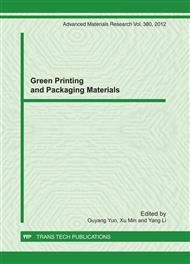[1]
R.A. Baker, E.A. Baldwin and M.O. Nisperos-Carriedo: Edible Coatings and Films for Processed Foods (Technomic Publishing, Lancaster 1994).
Google Scholar
[2]
A. Gennadios, A.H. Brandenburg, J.W. Park, C.L. Weller and R.F. Testin: Ind. Crops Products. 2(1994), p.189–195.
DOI: 10.1016/0926-6690(94)90035-3
Google Scholar
[3]
A. Gennadios, M.A. Hanna and L.B. Kurth: Lebensm.-Wiss. Technol. 30(1997), p.337–350.
Google Scholar
[4]
M.I. Porcella, G. Sánchez, S.R. Vaudagna, M.L. Zanelli, A.M. Descalzo, L.H. Meichtri, M.M. Gallinger and J.A. Lasta: Meat Sci. 57(2001), p.437–443.
DOI: 10.1016/s0309-1740(00)00122-4
Google Scholar
[5]
S.K. Park, C.O. Rhee, D.H. Bae and N.S. Hettiarachchy: J. Agr. Food Chem. 49(2001), p.2308–2312.
Google Scholar
[6]
J.W. Rhim, J.H. Lee and P.K.W. Ng: Lebensm.-Wiss. Technol. 40(2007), p.232–238.
Google Scholar
[7]
J.F. Su, Z. Huang, Y.H. Zhao, X.Y. Yuan, X.Y. Wang and M. Li: Ind. Crops Products. 31(2010), p.226–276.
Google Scholar
[8]
F.M. Monedero, M.J. Fabra, P. Talens and A. Chiralt: J. Food Eng. 97(2010), p.228–234.
Google Scholar
[9]
ASTM (1995) Standard Test Method for Gas Transmission Rate of Plastic Film and Sheeting. Designation: D 3985-1995. In annual book of ASTM standards; American Society for Testing and Materials: Philadelphia, PA 532–537.
Google Scholar
[10]
ASTM. (1995) Standard Test Method for Water Vapor Transmission Rate through Plastic Film and Sheeting Using a Modulated Infrared Sensor. Designation: F 1249-90. In annual book of ASTM Standards, American Society for Testing and Materials: Philadelphia, PA 1137–1141.
DOI: 10.1520/f1249-90r95
Google Scholar
[11]
C.E. Rogers: Permeation of Gases and Vapors in Polymers (Elsevier Applied Science, London 1985).
Google Scholar
[12]
D.M. Napierala. & A.Nowotarska. Acta Agrophys. 7(2006), p.151–159.
Google Scholar
[13]
X.D.Yu, A.L. Wang. & S.Q. Cao. Desalination. 62(1987), p.293–297.
Google Scholar
[14]
A. Gennadios , C.L. Weller and R.F. Testin: J. Food Sci. 58(1993), p.212–214, 219.
Google Scholar
[15]
J.A. Torres: Edible Films and Coatings from Protein (Dekker, New York 1994).
Google Scholar


